|
On the night walk we were fortunate to see several rare creatures in a flowering Sapote tree. This isn't a
native, it comes from South America. But the day shift (honeyeater birds) and the night shift
(fruit bats, possums, and other mammals) don't care. They love it. We caught this striped possum, although
with our red spotting torch the colours aren't quite right. These little guys are
just black and white...and would fit in your hand. Might fix the colour in fancy software when we
get home. In this photo the striped possum is upside down. They seem to be just as happy upside down
and downside up. If you can't make out this picture have a look at the bigger version (click on it), and/or
look at the next picture which should give you more reference points for the face and what it looks like.
|

|

|
For those of you in Australia this is a lovely sight. For those of you in New Zealand: this is not a
scruffy brushtail possum eating our forests and bringing tuburculosis and other diseases to our
dairy cattle. Kiwis need to adjust their feelings when in Australia because we generally treat
possums the way Aussies treat the dreaded
Cane Toad .
Possums are lovely in their own environment where
they belong. In addition to this rare striped possum we saw a
green ringtail possum and the rarely
seen and a
prehensile tailed rat.
(now called a tree mouse in our reference book). Don't know if tree mouse
sounded better for P.R. purposes than rat. But I'm no taxonomist.
|
|
One of the must see places for birds on the tableland is Hasties Swamp. There is a fine quality
bird hide (two stories!), and always something to see out on the water. Here are some whistling ducks taking a break. There
were also lots of magpie geese further along, and we watched them head off to the nearby farm fields to
eat each day. At least we think that's what they were after. When they aren't over in the fields they
are at a more grassy end of the swamp eating something else. We didn't stop to ask them.
|
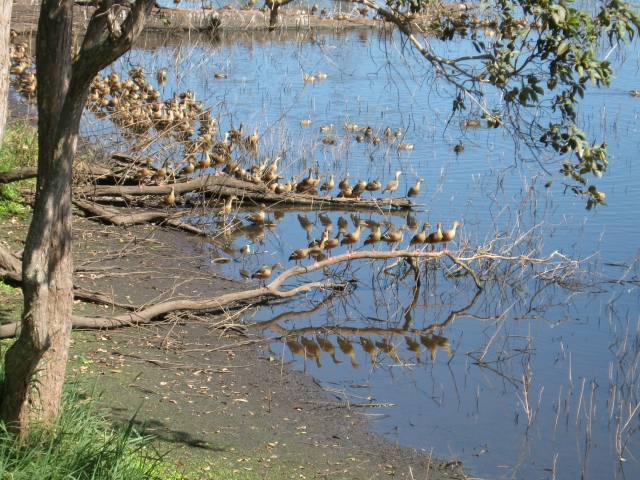
|
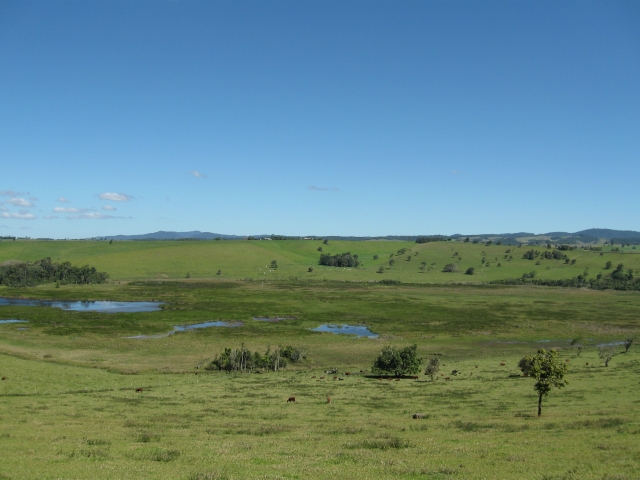
|
Another lot of daily commuters are the Brolgas. They return at night to Bromfield Swamp which is down
the road from Hasties. Bromfield is an easy recognizable volcano crater shape (especially if you are
used to this sort of countryside from New Zealand). We went to the edge several evenings to enjoy
flights of Brolgas trumpeting to one another as they come in low over the edge. Then it's landing
gear down and a sort run on the ground before they come to rest. Big crane, needing
a bit of runway. You can't get a close up
of them at Bromfield, so good old Wikipedia can help
Brolga up your day.
|
|
The other big thing around Kingfisher Park is the frogs in the showers. These are giant tree frogs, but
they seem to like to live in the shower and toilet blocks as well. They tuck themselves into corners
during the drier times and come out when it is moist. Which is why they like to be right in
the shower cubicles like this one. They are a bit bigger than your hand when they stretch out
their limbs. It hasn't happened to us, but you just hope that they don't decide to leap on
you while you are in the middle of your shower. There are enough bitey things around that
one doesn't want anything jumping on one's person! During the latter part of our time
up North the snakes are waking up and for a time we were seeing one a day. Jan got quite surprised
by one which leapt out and caught a frog right behind her chair while we were sitting outside. I looked
up to see the head slowing withdrawing into the bushes with a squirming frog in its mouth. Keith assured
us this was a tree snake which is not poisonous and only eats frogs. We've never really had a chance
to learn the poisonous ones from the harmless ones -- neither they nor we stay close enough long enough.
|

|

|
We also had a one day outing down off the tableland to Mossman and vicinity. We called in at Port Douglas
(not our scene)and Mossman Gorge (overrun with tourists)and went up into a less populated hinterland
area where we ate lunch at a great place called
High Falls Riverside Restaurant . We also called in at a glassworks
which look awfully familiar: Hoglund Glass
which exists like us as migrants between New Zealand and Australia. You may have noticed by now that most of the
North Tropical Queensland business
only operate part of the year. This sign on the road to the glass gallery should give you a hint why.
Sometimes nobody
can get in or out for months in the wet season.
|
|
The grounds at High Falls are old demonstration gardens for various tropical fruits which
the Queensland Government was thinking might be taken up by growers. There are still lots
of interesting things there, some of which come back in the food. Jan and I each had a fantastic Sour Sop cheesecake.
I was first introduced to these fruits in the Solomon Islands in 1978 and haven't had one since. We found a tree with some
small ones on it, but Jan was more taken with the Jak Fruit. We had our famous rainbow umbrellas for strolling
about because there were showers. The notebook in her hand is the guide to the
demonstration garden which has numbers on the sample trees. It has photos of all the different fruiting
trees and gives information about them. They even had a Jaboticaba (Myrciara Cauliflora) which
is the tree we have in our garden in Auckland.
|

|

|
One of the things which we found hard to come by at Kingfisher was mobile phone coverage or
internet connectivity. This doesn't usually cause a problem, but we had a few things
we needed to check up on, so we decided to head to someplace with coverage. We guessed
that if we headed South to Lake Mitchell and drove out on the causeway that would do
the trick. So we combined a bit of bird watching with signal gathering. Here is Steve communicating
with the rest of the world.
|
|
We headed off from Kingfisher and went camping for a few days around the back of Lake Tinaroo. We left
Kingfisher packing up in the rain, and arrived in Atherton to dry out in a cabin. Then we packed up
our dry things and camped at Lake Tinaroo, until we...packed up in the rain and headed off. They don't
call this place Wet Tropics for nothing. This time we dried out a bit further inland. You only have to go 60-70km
inland here and the climate changes dramatically. Dry and hot. On the way we passed this amusing
bit of witty banter via signs. Part of Steve's ever growing collection of amusing Australian signs. We dried out
at Innot Hot Springs for a night (although we only had to put the tent up for a couple of hours
and it was bone dry). Nice to have a soak in hot springs. The next morning we packed up and headed
off for a bit of inland back road adventure.
|

|

|
First we headed to remote Blencoe Falls, which is down a dirt
farm road heading South out of Mt Garnett. We had been down this way before but didn't check out the
falls which are on an even smaller
side road. This time we did and were rewarded by some spectacular views and great camping by
Blencoe Creek. This view of
the falls was the first we had and it was up a 5 km 4WD track just before the actual camping. We
didn't actually see the sign warning that this was a full blown 4WD track because it was placed
for traffic coming from the campground. I guess you are supposed to call in there first. Fortunately,
our trusty Trev didn't mind at all. That's what he is built for.
|
|
Also up at the lookout were hoop pines. We are familiar with them from many other areas
because they seem to be used quite a bit in Queensland Government Forestry plantations. But these ones
also had very interesting orchids growing on them. We think these are called "pencil orchids" but
we're not sure. Given they are hanging out of trees which are themselves hanging over a big cliff
which goes down to the falls we weren't going to get a whole lot closer to them!
|

|

|
Just to give you an idea of the remote nature of this road, this is one of the bridges you
cross. There are a couple of these with the planks going longitudinally. We're used to
ones with the planks going the other way and you make a "boodle-oo boodle-oo" sound
as you cross. With these longitudinal ones you just go very slowly and try and keep
your wheels from following the wrong set of tracks. We seemed to be the only people at
the campgrounds despite our guide book saying it was a very popular place. That may have to
do with the uncertain state of the shorter road in from Kennedy down on the coast. Various
authorities say it is officially unmaintained, used by locals, fixed up since cyclone Larry, or
still closed. We were advised to bring a chainsaw if we went that way in case another tree
had fallen over it.
|
|
Another sign of being pretty remote is a lack of signs. Well, at least the one you
want. Here is the fork in the road where you have to go left to get to the falls
or right to get further South. No hints about where Blencoe Falls is at this point. The signing
for Blencoe Falls
was pretty good earlier on when you left Mt Garnett, but they seem to have run dry
by the time they got down here.
|

|

|
The other thing you need to watch out for along the roads here is critters of various sorts.
We came across a pretty big goanna crossing the road and he took off at a great speed as
soon as he saw us and shot into a hollow log by the side of the road. We also saw a dingo
(we usually see at least one on every trip) which might have been a half breed. We didn't get a close
look because like the goanna it was off as soon as it spotted us. On the other hand, this
emu sauntered into the road and spent some time cruising along. We went very slowly
(Trev is our portable bird hide) and the emu paced us along
the side. Not running from us, but just strolling in the same direction we were going.
|
|
The first emu joined his mates, so we stopped for a time and watched them off the side of the road in longer
grass. This sort of travelling is great, but it is one of the reasons we don't go very far in a day.
More things hide in the long grass than just emu, which is another reason to drive slowly. But this is also
the reason we prefer to travel on little unsealed side roads rather than up the main highway -- you
get to see more wildlife and you can stop safely to have a closer look.
|

|

|
You never know when something is going to zoom out on the road just ahead of you, and
kangaroos are notorious for having little "road sense".
We wouldn't to run over one of these little cuties.
This is a "Prettyface" or Whiptail Wallaby. Jan was delighted because she remembers these
from her childhood growing up in Southern Queensland.
|
|
First one popped up.
Then there were two. Eventually a third popped up as all three headed away from the road for the hills behind. So this was
a one dingo, one goanna, three emu and many whiptails sort of a day. Of course we have seen lots of other kangaroos and
wallabies in our travels, but the whiptails stand out. But you only get a photograph of 1 out of 100 you
actually see. Usually they take of before you can even think about getting the camera pointed at them.
|

|
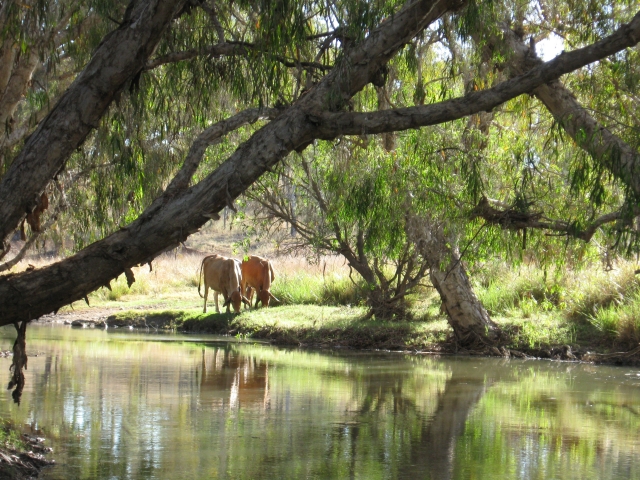
|
We rang ahead from Mt Garnett to get permission to camp at Reedy Brook Station. The owners George and
Audrey Harriman very kindly allow people to camp there but we wanted to check in and be sure it was
ok. This is all part of good manners on station properties, and unfortunately sometimes people assume
they can just camp anywhere and don't take all their rubbish with them. When we arrived
we found some very contented looking cows, and chose a site shaded by some paperbark trees.
|
|
Here is our campsite right by the brook. The water flows at considerable pace, and eventually ends
up as the Burdekin River which comes out on the coast between Ayr and Home Hill. We've been to
the Burdekin dam downstream, and looked at the area of the river mouth, so it was great to discover
what the source looks like. Jan found a nice low level area of this area on the web which shows
the complex channel structure in this area, but we failed to bookmark it and I can't place
it here yet. It may be here if you check back another time. Serious internet searchers are
welcome to find it and email me the link.
|

|

|
It turns out we were a week late for a charity cricket event called The Ashes
which is held at Reedy Brook.
There were still some pieces of infrastructure around (long drops and covered seating) but the cows
had alread moved back in to the area of the pitch. If you enlarge the photo and look carefully you
will see a monument mentioning Valley of Lagoons. This is nothing to do with the cricket, it
commemorates a place where the early European explorer Ludwig Leichhardt camped. It is also the
name of the next property along, which has several large lagoons and is a haven for
water birds just like Reedy Brook. We passed Valley of the Lagoons (the station not the locality)
on our way out to the coast.
We popped out
from this back road diversion and found ourselves back in Ingham. We had planned to camp at Broadwater,
but when we started going in that direction there were big black clouds and rain. Since we have
been to Broadwater twice before, we chickened out
and decided to head South instead which was out from under the clouds.
|
|
So we returned to Crystal Creek for more camping and swimming in Paradise Pool. We didn't get rained
on, and the weather was good. Ingham must have been at the junction of two weather systems
because we are only talking 80-100 km one way or the other. We didn't manage to get
a photo last time so we took special care to get one for you this time!
|
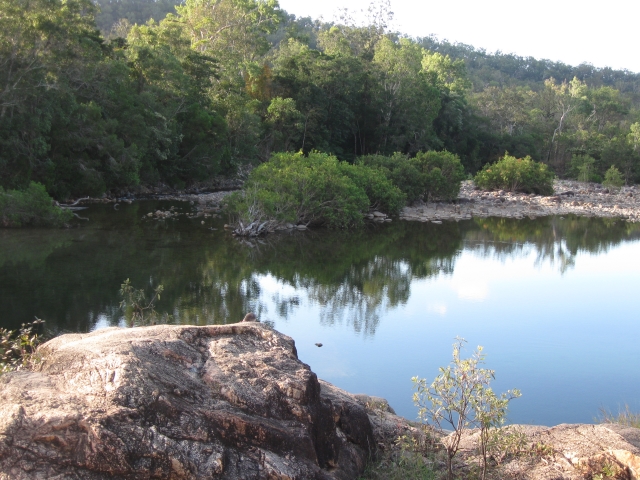
|

|
We met up with a more friendly (well, less scared) goanna who visited our camp. He seemed to
live in a hole in a tree which was next to us. We saw him climb up a few times
and he seemed to stay in the hole overnight. Also in that tree a brown backed honeyeater
nest was being built, but it was out on a very thin branch and probably safe from
a goanna looking for eggs. We've seen a few nests this year and are catching on
to how they are built and located to avoid snakes and goannas.
|
|
Up the creek from Paradise Pool is another area called the Rock Slides. We made a
trek up there. Lots of youngsters go there for the thrill. Steve tried one of the
slides out to
good effect. Jan took photos. While Steve was sliding there was a young German tourist
who joked with Jan saying: "There
are slides like this all over Europe. Except that they are made of plastic
and indoors". That says a lot about why there are so many young Europeans travelling in
Australia and New Zealand to enjoy the raw natural environment.
|

|
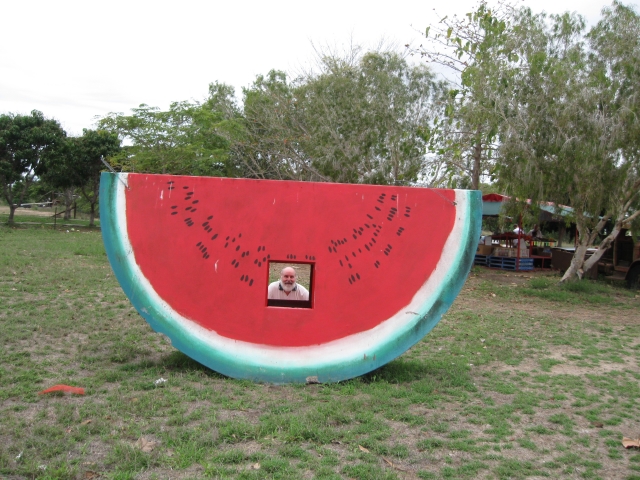
|
On the way to Bowen we stopped at a fruit and vegetable roadside stall and stocked up. This is in Gumlu, which is
a small community North of Bowen. They are fairly close together and the Growers associations straddle the two areas. The Gumlu/Bowen
area produces most of the tomatoes and capsicums in Australia, I believe. You may have heard about them
in the news because somebody
put herbacide into the feed lines
at the nursery
facilites and took out much of next years tomato crop at the seedling stage.
Farmers have to put up with all sorts of environmental challenges
(floods, droughts, cyclones, insects)
without people doing damage as well. But they are
a resiliant lot and they will keep on. On a happier note, there was
a great watermelon where kids could get their picture taken at the roadside stall. I love watermelon. Enough said.
|
























